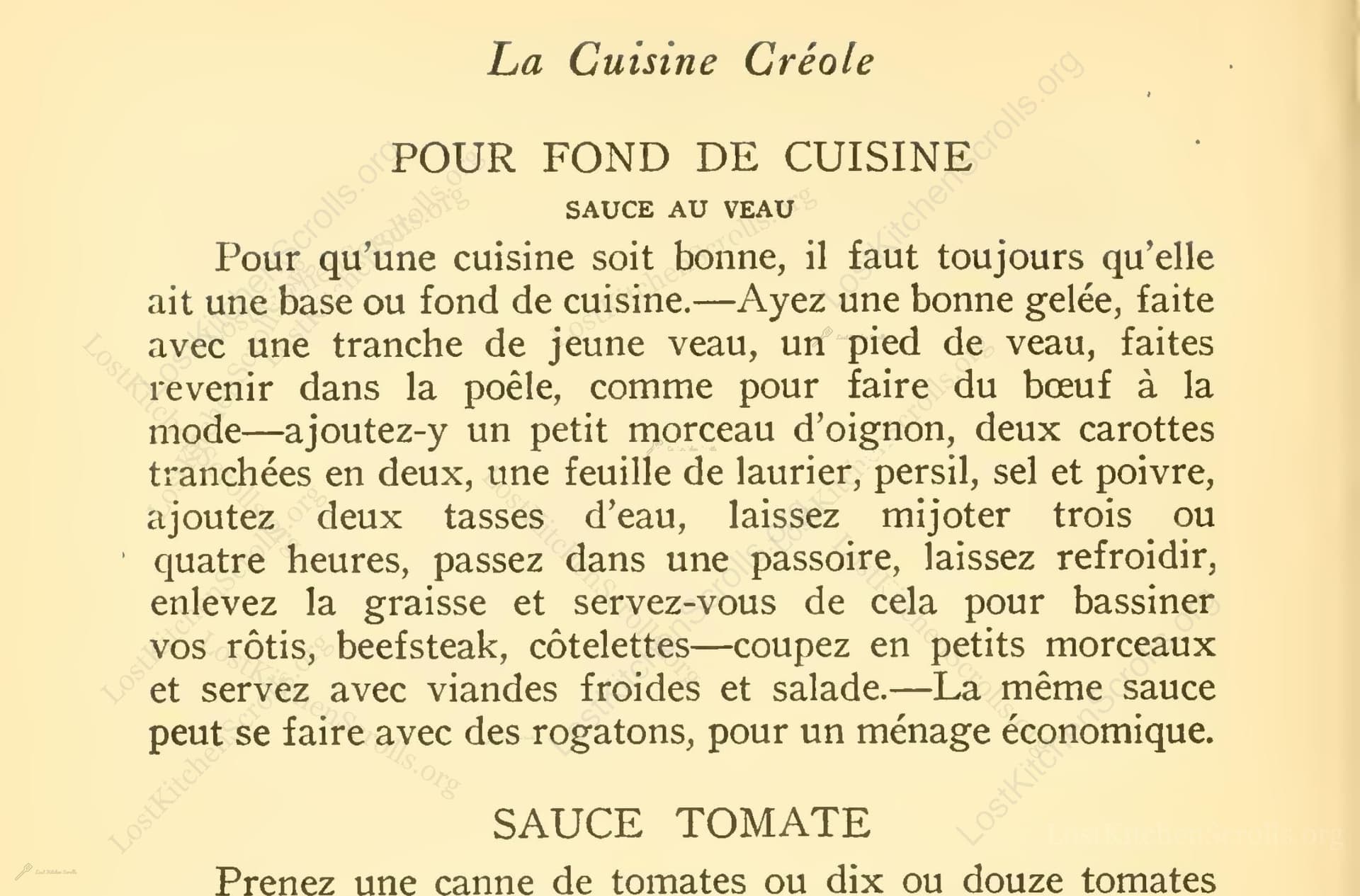Pour Fond De Cuisine Sauce Au Veau
From the treasured pages of Cooking in old Créole days. La cuisine créole à l'usage des petits ménages
Written by Célestine Eustis

Pour Fond De Cuisine Sauce Au Veau
"Pour qu'une cuisine soit bonne, il faut toujours qu'elle ait une base ou fond de cuisine.—Ayez une bonne gelée, faite avec une tranche de jeune veau, un pied de veau, faites revenir dans la poêle, comme pour faire du bœuf à la mode—ajoutez-y un petit morceau d'oignon, deux carottes tranchées en deux, une feuille de laurier, persil, sel et poivre ;—ajoutez deux tasses d'eau, laissez mijoter trois ou quatre heures, passez dans une passoire, laissez refroidir, enlevez la graisse et servez—vous de cela pour bassiner vos rôtis, beefsteak, côtelettes—coupez en petits morceaux et servez avec viandes froides et salade.—La même sauce peut se faire avec des rogatons, pour un ménage économique."
Note on the Original Text
Historical recipes such as this were written for an audience familiar with both technique and thrift, so instructions are concise, ingredients may lack precision, and steps are implied. Measurements were often estimated ('a small piece of onion'), and written in a friendly, conversational tone. 'Fond de cuisine' denotes the culinary foundation—the stock—while 'gelée' signals the expectation of natural gelatin from simmered bones. Spellings and phrasing reflect both French influence and English transliteration typical of Creole communities in the early 1900s.

Title
Cooking in old Créole days. La cuisine créole à l'usage des petits ménages (1903)
You can also click the book image above to peruse the original tome
Writer
Célestine Eustis
Era
1903
Publisher
R.H. Russell
Background
Take a delicious journey back in time with this charming bilingual collection of Creole and American recipes, crafted for cozy households. Célestine Eustis blends French flair with Southern soul, guiding both the novice and seasoned gourmand through the distinct flavors and delightful traditions of old Creole kitchens.
Kindly made available by
Internet Archive
This recipe is drawn from the vibrant world of Louisiana Creole cooking at the turn of the twentieth century. 'Cooking in old Creole days' captures the everyday ingenuity of the petit ménage—the small, often frugal, urban households of Francophone New Orleans. In these kitchens, resourcefulness meant that nothing was wasted: stocks made from veal off-cuts and bones became the backbone of countless sauces and braises. Food was a celebration of both French culinary heritage and the local bounty. The book, written in both French and English, bridges two culinary cultures at a time when Creole identity was proudly asserted in America's bustling port cities.

Cooks of the era relied primarily on heavy iron or copper pots and skillets, wood-fired or coal stoves, kitchen knives for jointing meat, and a simple passoire (strainer) or cheesecloth to filter the stock. Fat was skimmed with large spoons after cooling in earthenware bowls. The absence of refrigeration meant stocks had to be used promptly or clarified for longer keeping.
Prep Time
15 mins
Cook Time
4 hrs
Servings
4
We've done our best to adapt this historical recipe for modern kitchens, but some details may still need refinement. We warmly welcome feedback from fellow cooks and culinary historians — your insights support the entire community!
Ingredients
- 1 lb 2 oz young veal (shoulder or breast)
- 1 veal foot, cleaned and split (substitute: extra bones/joints if unavailable)
- 1.5 oz onion (about 1/2 small onion)
- 7 oz carrots (2 medium carrots, cut in half)
- 1 bay leaf
- a handful fresh parsley
- salt, to taste
- black pepper, to taste
- 2 cups cold water
Instructions
- To create a flavorful veal stock, start by taking approximately 1 lb 2 oz of young veal (such as a slice from the shoulder or breast) and one veal foot, cleaned and split.
- In a large skillet or heavy-bottomed saucepan, brown the veal meat and foot, just as you would when searing beef for stew.
- Add half a small onion (about 1.5 oz), two medium carrots (about 7 oz) split lengthwise, one bay leaf, a handful of fresh parsley, and season generously with salt and freshly ground black pepper.
- Pour in about 2 cups of cold water.
- Bring gently to a simmer, and allow it to cook very slowly for 3-4 hours, skimming periodically.
- Strain through a fine sieve or cheesecloth, discard solids, then let the liquid cool completely so the fat rises to the top—remove this fat before using.
- This gelatin-rich stock can baste roasts, enrich beefsteak or cutlets, or be diced and served with cold meats and salad.
- For budget cooking, the same method can be applied using leftover cooked meats and bones.
Estimated Calories
120 per serving
Cooking Estimates
Preparing the ingredients and browning the meat takes about 15 minutes. Cooking the stock slowly takes around 4 hours. This recipe makes about 4 servings of veal stock. Each serving has roughly 120 calories. These values are typical for homemade veal stock.
As noted above, we have made our best effort to translate and adapt this historical recipe for modern kitchens, taking into account ingredients nowadays, cooking techniques, measurements, and so on. However, historical recipes often contain assumptions that require interpretation.
We'd love for anyone to help improve these adaptations. Community contributions are highly welcome. If you have suggestions, corrections, or cooking tips based on your experience with this recipe, please share them below.
Join the Discussion
Rate This Recipe
Dietary Preference
Main Ingredients
Culinary Technique
Occasions

Den Bockfisch In Einer Fleisch Suppen Zu Kochen
This recipe hails from a German manuscript cookbook compiled in 1696, a time whe...

Ein Recht Guts Latwerg
This recipe hails from a late 17th-century German manuscript, a comprehensive co...

Einen Schweinß Kopf Zu Kochen
This recipe hails from the 'Koch Puech', a lavish and encyclopedic German cookbo...

Krebse Zu Kochen
This recipe hails from a 1696 anonymous German manuscript, ‘Koch Puech,’ a time ...
Browse our complete collection of time-honored recipes



